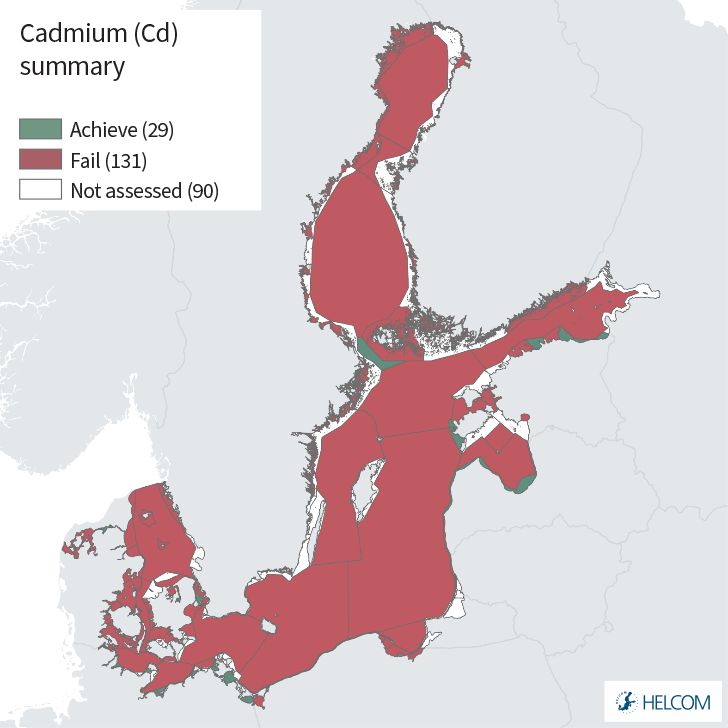 Cadmium
Cadmium
2 Relevance of the indicator
Cadmium has historically entered the Baltic Sea at elevated levels due to human activities and has known negative environmental impacts where concentrations exceed acceptable levels. Emissions still occur from combustion activities (fuel), batteries, fertilizers, fireworks and certain paints.
2.1 Ecological relevance
Heavy metals, including cadmium (Cd) are toxic to wildlife and humans, and even at low levels, they can be harmful to marine organisms. The severity of the effect mainly depends on the concentration in the tissues. Additionally, Cd is known to biomagnify, i.e. the concentration levels increase upwards through the food chain. When heavy metals bioaccumulate in tissues they can cause different biological effects on the individual organism, which transform into changes at the population, then species level, and finally affect biodiversity and ecosystem functioning. Heavy metal accumulation in fish, specifically destined for human consumption, directly affects human health.
Cadmium is an element relatively sparse in the earth’s crust, but significant amounts of it have been introduced into the environment as a result of human activities and it poses a serious threat to human and animal health. Cadmium is relatively widely used in industry for the production of dyes and stabilizers of plastics and electroplating protective coatings, solders and alloys, and cadmium rods. It is also used in the production of nickel-cadmium alkaline batteries, fireworks, and fluorescent paints. Chemical fertilizers (e.g. superphosphates) are a significant source of cadmium in the environment. Fuel combustion processes are also a very important source of cadmium.
Once introduced into the environment, cadmium is not subject to degradation and remains in constant circulation. This can result in the bioaccumulation of large amounts of cadmium and its toxic effects on organisms. It causes the greatest damage to organs in which it accumulates easily, for example in fish liver. It can damage DNA and is carcinogenic.
2.2 Policy relevance
The core indicator evaluating concentrations of the metal Cadmium (Cd) addresses a major goal and various ecological objectives of the Baltic Sea Action Plan (BSAP 2021). This includes the goal of the hazardous substances and litter segment of a ‘Baltic Sea unaffected by hazardous substances (and litter)’, and key ecological objectives of: ‘Marine life is healthy’, ‘Concentrations of hazardous substances are close to natural levels’, and ‘All sea food is safe to eat’. There is also relevance for the BSAP biodiversity goals (Table 1).
Table 1. Overview of key policy relevance elements.
| Baltic Sea Action Plan (BSAP) | Marine Strategy Framework Directive (MSFD) | |
| Fundamental link | Segment: Hazardous substances and litter goal
Goal: “Baltic Sea unaffected by hazardous substances and litter”
|
Descriptor 8 Concentrations of contaminants are at levels not giving rise to pollution effects.
|
| Complementary link | Segment: Biodiversity
Goal: “Baltic Sea ecosystem is healthy and resilient”
|
Descriptor 9 Contaminants in fish and other seafood for human consumption do not exceed levels established by Union legislation or other relevant standards.
(a) for contaminants listed in Regulation (EC) No 1881/2006, the maximum levels laid down in that Regulation, which are the threshold values for the purposes of this Decision; (b) for additional contaminants, not listed in Regulation (EC) No 1881/2006, threshold values, which Member States shall establish through
|
| Other relevant legislation: |
|
|
The core indicator also addresses the following qualitative descriptors of the MSFD for determining good environmental status (European Commission 2008a), in particular being of direct relevance to Descriptor 8 and of significance for Descriptor 9 as set out under the specific Descriptors and Criteria in Commission Decision (EU) 2017/848.
Cadmium is listed as a priority substance (European Commission 2013, Annex 1) , monitoring under the WFD is done in the Water matrix.. As highly toxic, cadmium is included in the recommendations concerning the acceptable levels in products for consumption including seafood (European Commission 2006a) and in EU Shellfish directive (European Commission 2006b).
Article 3 of the EU directive on environmental quality standards states that also long-term temporal trends should be assessed for substances that accumulate in sediment and/or biota (European Commission 2008b).
2.3 Relevance for other assessments
The status of the Baltic Sea marine environment in terms of contamination by hazardous substances is assessed using several core indicators. These core indicators focus on contaminants with well-established knowledge base on their environmental impacts, often accompanied by long-standing monitoring activities. These core indicator contaminants include e.g. heavy metals (Pb, Cd and Hg), PAHs, PCBs and PCDD/Fs. Each of these indicators focuses on one important aspect of the complex issue and are further used in producing an overall hazardous substances assessment. Cd as one of the metal indicators will give an evaluation of the status in terms of heavy metals concentration. The Cadmium indicator will be included in the integrated hazardous substances assessment, using the HELCOM hazardous substances assessment tool CHASE.
3 Threshold values
Good Environmental Status (GES) is achieved if the concentrations of metals are below the specified threshold values for each relevant monitoring matrix, as illustrated in Figure 2.
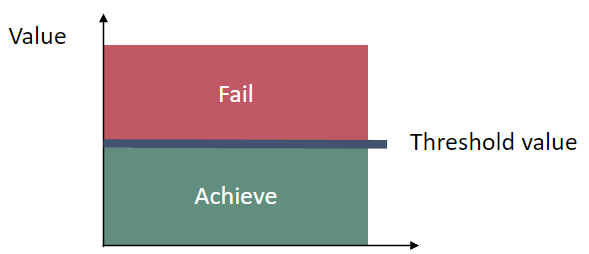
Figure 2. Good Environmental Status (GES) is achieved if the concentrations of metals are below the agreed threshold value.
The threshold value for cadmium is based on Environmental Quality Standards (EQS) for water as a primary matrix (Table 2) which have been defined at the EU level for substances included in the priority list under the Water Framework Directive, WFD (European Commission 2000, 2013). For historical reasons, the countries around the Baltic Sea have differing monitoring strategies and data on cadmium concentrations in water are not available in all regions of the Baltic Sea. In order to perform the evaluation based on other matrices, secondary thresholds were proposed: QS for sediments and values based on scientific studies for fish muscle, fish liver and mussel soft tissue (Table 2). Under the WFD, Member States may establish other values than EQS for alternative matrices if specific criteria are met (see Art 3.3. in European Commission 2008b, revised in European Commission 2013).
Table 2. Threshold values for Cadmium (EQS – Environmental Quality Standard, AA- Annual Average Concentration, QS – Quality Standard, BAC = Background Assessment Criteria). Underlined supporting parameters represent parameters without which the indicator evaluation can not be applied. MU = muscle, LI = fish liver, SB = soft body, CORG = organic carbon, Al = Aluminium, Li = Lithium. European Commission Directive 2008/105/EC, Cadmium and its compounds – Europa EU, 2005, and EG HAZ 16-2021 document 3-4.
| Indicator | Threshold value | Parameters (PARAM) / Parameter groups (PARGROUP) (see also http://vocab.ices.dk/) | Matrix | Species | Matrix | Basis | Supporting parameters and information |
| Metals
(Cd) |
Primary threshold
EQS water 0.2 µg/l |
PARAM = CD | Water | WT (filtered, unfiltered if the concentration is below the EQS) | Surface water layer (≤ 5.5 m) | ||
| Secondary threshold
EQS secondary poisoning (DK derived) 160 µg/kg ww mussels and fish (whole organism) |
Biota | Molluscs (M edulis + M. baltica + Dreissena polymorpha)
Herring & cod (open sea) Flounder, sole, eelpout & Perch (coastal) |
SB
Fish muscle & LI |
W
W |
Dry weight
Dry weight |
||
| *Secondary threshold
QS from EQS dossier 2.3 mg/kg sediment (DW). |
Sediment (surface, ICES ’upper sediment layer – 0-X cm’) | D | Al
Li CORG Grain size |
*Denmark retains a study reservation on this threshold value and is currently carrying out national work to review and evaluate a suitable threshold value, but supports the application of the regional indicator for HOLAS 3.
It should be noted that for HOLAS 3 and subsequent to HOLAS II a new threshold value has been implemented as well as the inclusion of the zebra mussel as one of the species included. The Secondary threshold value, an EQS secondary poisoning (DK derived) 160 µg/kg ww mussels and fish (whole organism). This overrides the previous threshold value applied in HOLAS II for mussels of 960 µg kg-1 d.w, an OSPAR BAC (Background Assessment Criteria) and for fish (liver) an OSPAR proxy BAC 26 µg/kg ww fish liver. The EQS for biota is applied to fish liver and muscle without any conversion applied, an aspect that needs to be addressed in future work.
3.1 Setting the threshold value(s)
The threshold values for cadmium are based on Environmental Quality Standards (EQS) for water as a primary matrix (Table 2) which have been defined at the EU level for substances included in the priority list under the Water Framework Directive, WFD (European Commission 2000, 2013). The EQS for cadmium was developed in 2005 but not revisited in the updated 2011 EU EQS dossiers. The original EU risk assessment for sediment used an uncertainty factor of 50 due to only one chronic dataset for freshwater (Chironomus sp), reduced from 100 as most short-term test showed very little difference in species sensitivity. A recent Danish evaluation expanded on the existing information pool by adding two extra studies, increasing the number of species to three (including two marine species), representing three systematic groups and reducing the uncertainty factor to 10. Further details are provided in EG HAZ 16-2021 document 3-4.
4 Results and discussion
The results of the indicator evaluation that underlie the key message map and information are provided below.
4.1 Status evaluation
The data applied for the core indicator evakluation is based on regular monitoring data gathered by HELCOM Contracting Parties and reported to the HELCOM COMBINE database (hosted by ICES). The indicator presents information on the current levels of cadmium concentrations in selected marine matrices: seawater, fish (muscle and liver), soft body of mussels and sediment for the period 2016-2021, assessed against regionally agreed threshold values. The values presented in the report refer to the concentrations and mean values calculated from them, while the status evaluations are based on the so-called representative concentrations assessed against threshold values, which result from data evaluation (see Methoodology), and are considered as values representative of status for the given assessment units.
Seawater
The primary matrix for cadmium is water, as the primary threshold value for the core indicator is agreed to be the EQS value for water. This is in conflict with the HELCOM COMBINE monitoring program, where the preferred matrix for monitoring is biota and sediment. As a result, very limited data is available for cadmium in water.
An evaluation was possible for 50 assessment units, of which 5 were open sea HELCOM sub-basins. All open sea assessment units achieved the threshold value (were in GES) and of the remaining assessment units 13 failed to achieve the threshold value (sub-GES) (Figure 3). However, cadmium concentrations in the seawater have been measured only by Germany, Estonia, Lithuania and Poland, and even in these instances in relatively low coverage and frequency.
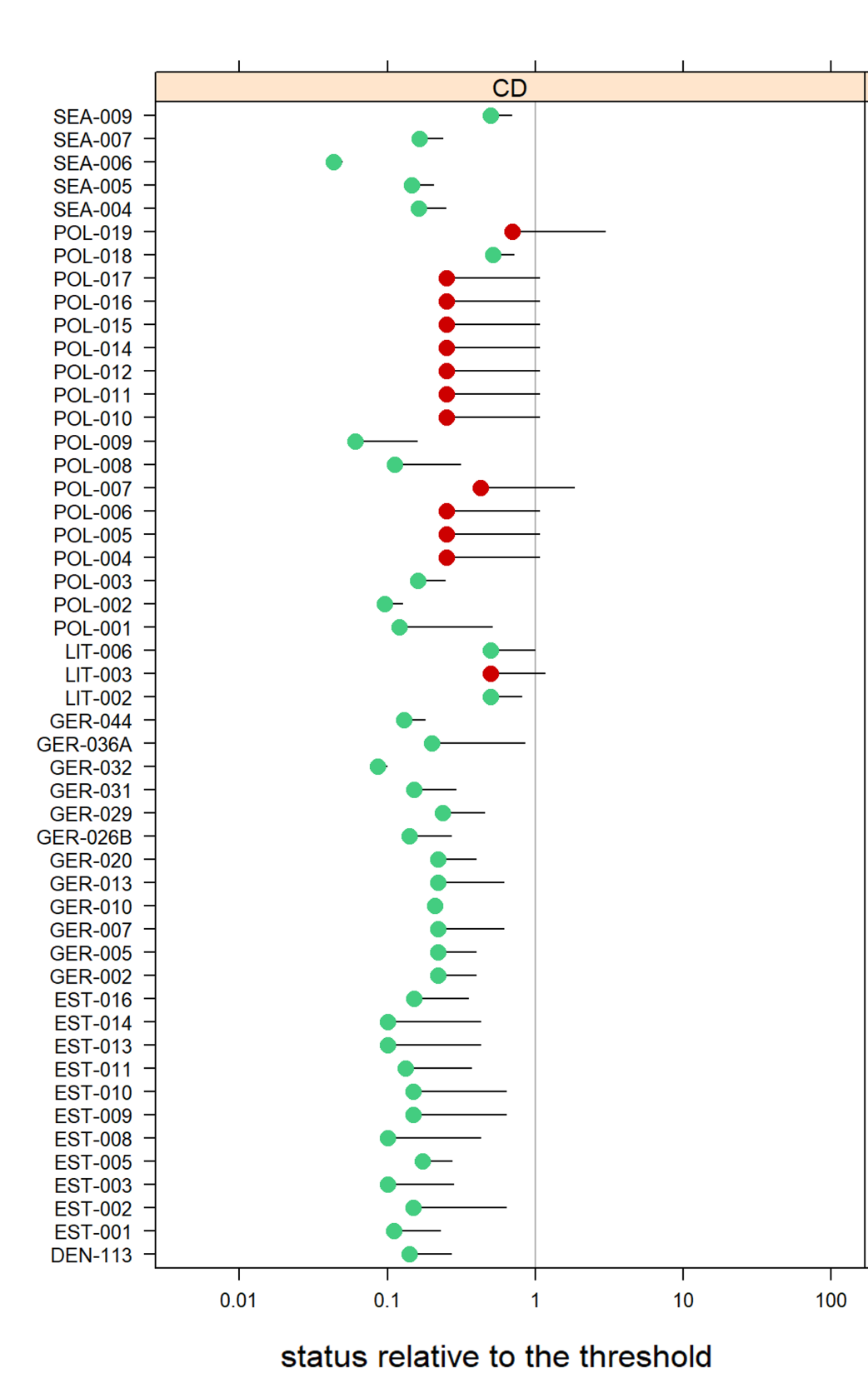
Figure 3. Overview of HELCOM Level 4 assessment units evaluated for Cadmium (Cd) in water. The 95% confidence limit on the mean concentration is presented. Filled circles represent a mean value for each assessment unit and the bar represents the upper 95% confidence limit. Green colour indicates that the assessed area achieves the threshold value and red colour that the assessed area fails the threshold.
The concentration in the last year of the evaluation (i.e. the most recent concentration in any given data series) is informative of latest reference point and will occur in the current assessment period. At the station level (i.e. per data series) the concentrations in the last year of evaluation (ug/l) varied, in cases somewhat widely even within a single sub-basin. This varied between and within the 17 HELCOM sub-basins when comparing all stations, inclusive of open sea and coastal, within each sub-basin (Table 3). These values show the variation across sub-basins and also the latest station level concentrations in the assessment period but do not themselves reflect status as status is derived from the entire assessment period and is also influenced by the 95% confidence limit on the mean concentration (as in Figure 3).
Table 3. Overview of number of stations within each HELCOM sub-basin (coastal and open sea per Level 2 assessment unit), the mean value of the concentrations in the last year of evluation across the stations and the lowest and largest of these values within each sub-basin (where evaluated).
| HELCOM sub-basin | Mean
(ug/l) |
Number of stations | Lowest concentration (ug/l) | Largest concentration (ug/l) |
| Kattegat (SEA-001) | NA | NA | NA | NA |
| Great Belt (SEA-002) | 0.03 | 1 | 0.03 | 0.03 |
| The Sound (SEA-003) | NA | NA | NA | NA |
| Kiel Bay (SEA-004) | 0.03 | 9 | 0.01 | 0.05 |
| Bay of Mecklenburg (SEA-005) | 0.03 | 9 | 0.01 | 0.04 |
| Arkona Basin (SEA-006) | 0.03 | 8 | 0.01 | 0.04 |
| Bornholm Basin (SEA-007) | 0.05 | 16 | 0.01 | 0.14 |
| Gdansk Basin (SEA-008) | 0.04 | 11 | 0.02 | 0.05 |
| Eastern Gotland Basin (SEA-009) | 0.09 | 12 | 0.05 | 0.10 |
| Western Gotland Basin (SEA-010) | NA | NA | NA | NA |
| Gulf of Riga (SEA-011) | 0.03 | 6 | 0.02 | 0.04 |
| Northern Baltic Proper (SEA-012) | 0.023 | 2 | 0.01 | 0.03 |
| Gulf of Finland (SEA-013) | 0.03 | 9 | 0.02 | 0.04 |
| Åland Sea (SEA-014) | NA | NA | NA | NA |
| Bothnian Sea (SEA-015) | NA | NA | NA | NA |
| The Quark (SEA-016) | NA | NA | NA | NA |
| Bothnian Bay (SEA-017) | NA | NA | NA | NA |
The status evaluation is derived based on the station level evaluation of 83 individual stations across the Baltic Sea region. Nine of these stations represented ‘full data’ (>3 years of data in the assessment period) and of these two distinct downward trends (e.g. decreasing concentrations) were recorded (these were also in GES). These stations were both located in the Bornholm Basin sub-basin. Other stations were evaluated as ‘initial’ data series (<2 years of data in the assessment period) due to the data available (Figure 4).
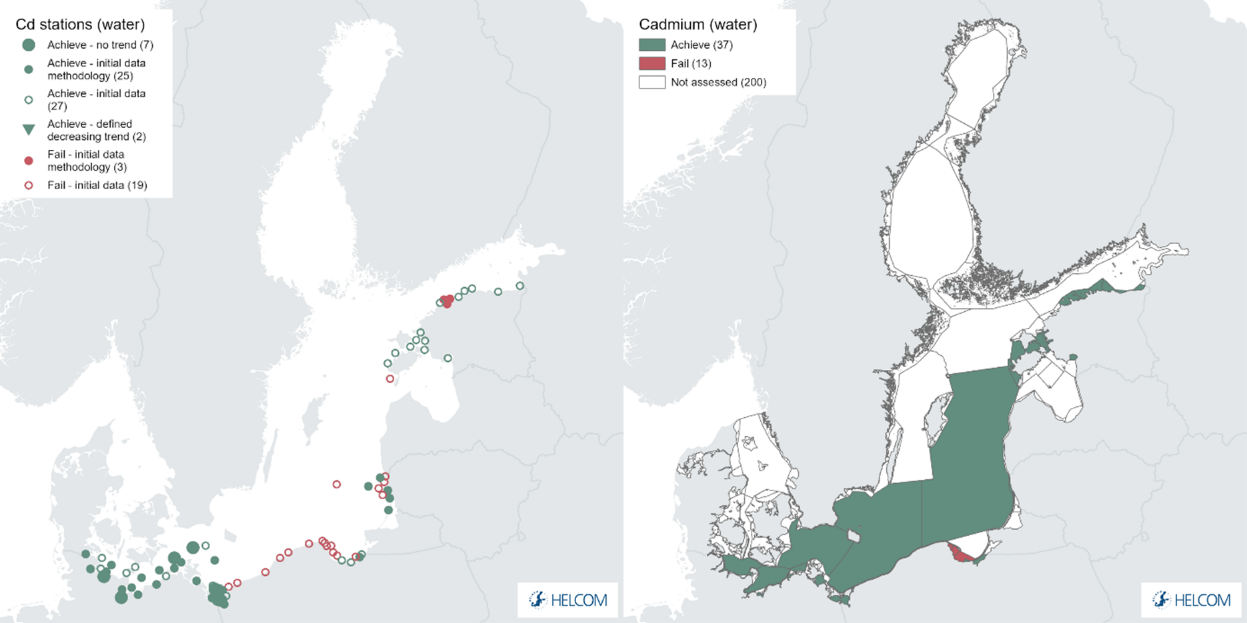
Figure 4. Map presenting station-based status of cadmium concentrations in seawater (left) and assessment unit based status evaluation for cadmium in seawater (right). Green colour represents good status and red colour represents not good status. Large filled triangles indicate data series of three or more years for which statistical trends could be assigned (upwards-increasing concentrations or downwards-decreasing concentrations), large filled circles triangles indicate data series of three or more years for which statistical trends could be assigned but where no detectible trend was observed, and full evaluation with MIME Script (see Methoidology) was carried out. Small filled circles represent data series of three or more years for which statistical trends could not be assigned due to specific data factors and open circles represent data series of less than three for which statistical trends could not be assigned due to data series length, and these data types are treated with initial status assessment (see Methodology). See ‘data chapter’ for interactive maps and data at the HELCOM Map and Data Service.
Stations with ‘full’ (>3 years of data in the assessment period) and ‘initial’ data (<2 years of data in the assessment period), the latter which limits the application of the full statistical analyses, were available to support the evaluation, though in general spatial and temporal aspects of the data set are limited at the Baltic Sea scale. Examples of different trend patterns at the station level (station time series) are presented in Figure 5.

Figure 5. Examples of Cadmium concentration in water at stations in the Bornholm Basin (left – distinct decreasing trend, ‘full data’), and the Arkona Basin (right – no distinct directional trend, ‘full’ data).
Biota
The evaluation of biota in the core indicator evaluating Cadmium (Cd) utilises fish muscle and liver (with no tissue conversion currently applied) of the following species: herring, cod, perch, flatfish, eelpout and soft tissues of mussels of the species: Mytilus edulis, Macoma balthica and Limnecola balthica. Biota is a secondary matrix for the Cd status evluation.
An evaluation was possible for 135 assessment units, of which 16 were open sea HELCOM sub-basins (of a possible 17 sub-basins). All but one open sea assessment unit (Eastern Gotland Basin, SEA-009) failed to achieve the threshold value (were sub-GES) and of the remaining 119 coastal station only 19 achieved the threshold value (were in GES) (Figure 6).
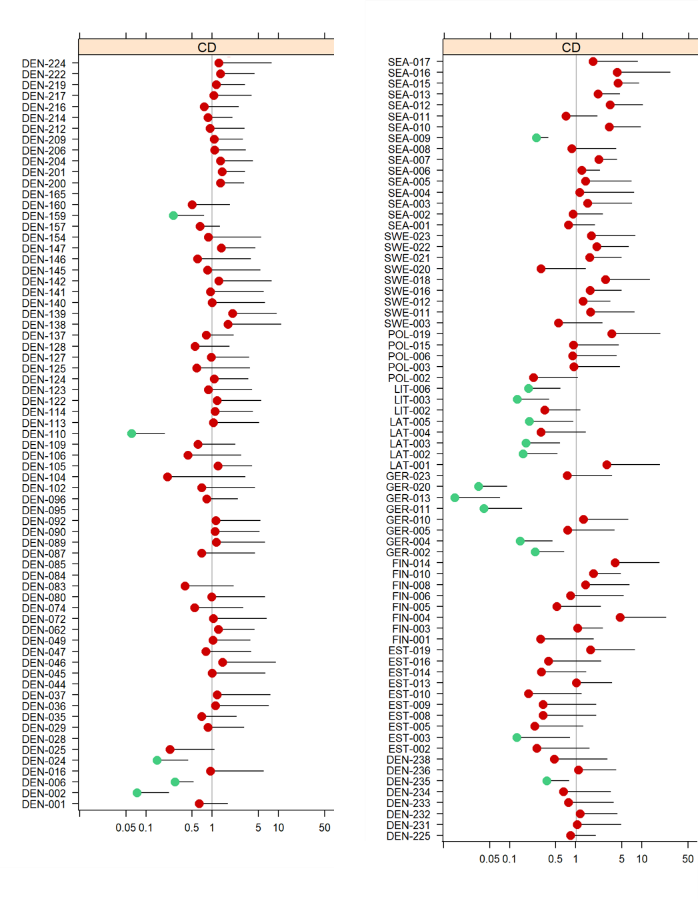
Figure 6. Overview of HELCOM Level 4 assessment units evaluated for Cadmium (Cd) in biota. The 95% confidence limit on the mean concentration is presented. Filled circles represent a mean value for each assessment unit and the bar represents the upper 95% confidence limit. Green colour indicates that the assessed area achieves the threshold value and red colour that the assessed area fails the threshold.
The concentration in the last year of the evaluation (i.e. the most recent concentration in any given data series) is informative of latest reference point and will occur in the current assessment period. At the station level (i.e. per data series) the concentrations in the last year of evaluation (ug/kg) varied, in cases somewhat widely even within a single sub-basin. This varied between and within the 17 HELCOM sub-basins when comparing all stations, inclusive of open sea and coastal, within each sub-basin (Table 4). These values show the variation across sub-basins and also the latest station level concentrations in the assessment period but do not themselves reflect status as status is derived from the entire assessment period and is also influenced the 95% confidence limit on the mean concentration (as in Figure 6).
Table 4. Overview of number of stations within each HELCOM sub-basin (coastal and open sea), the mean value of the concentrations in the last year of assessment across the stions and the lowest and largest of these values within each sub-basin (where evaluated). It should be noted that a significant contribution to the large range in values presented for biota is due to the presentation of liver and muscle values together.
| HELCOM sub-basin | Mean
(ug/kg) |
Number of stations | Lowest concentration (ug/kg) | Largest concentration (ug/kg) |
| Kattegat (SEA-001) | 152 | 52 | 2 | 920 |
| Great Belt (SEA-002) | 160 | 75 | 1 | 740 |
| The Sound (SEA-003) | 209 | 8 | 1 | 660 |
| Kiel Bay (SEA-004) | 170 | 2 | 137 | 202 |
| Bay of Mecklenburg (SEA-005) | 360 | 9 | 22 | 699 |
| Arkona Basin (SEA-006) | 234 | 21 | 27 | 618 |
| Bornholm Basin (SEA-007) | 300 | 12 | 19 | 1034 |
| Gdansk Basin (SEA-008) | 109 | 3 | 34 | 257 |
| Eastern Gotland Basin (SEA-009) | 212 | 30 | 1 | 838 |
| Western Gotland Basin (SEA-010) | 451 | 5 | 160 | 729 |
| Gulf of Riga (SEA-011) | 135 | 14 | 1 | 279 |
| Northern Baltic Proper (SEA-012) | 164 | 4 | 67 | 207 |
| Gulf of Finland (SEA-013) | 145 | 14 | 62 | 220 |
| Åland Sea (SEA-014) | 86 | 2 | 36 | 137 |
| Bothnian Sea (SEA-015) | 89 | 16 | 14 | 143 |
| The Quark (SEA-016) | 103 | 5 | 4 | 157 |
| Bothnian Bay (SEA-017) | 138 | 8 | 1 | 229 |
The status evaluation is derived based on the station level evaluation of 272 individual stations across the Baltic Sea region. Eighty-one of these stations represented ‘full data’ and of these 18 distinct downward trends (e.g. decreasing concentrations) were recorded (5 of which were in GES). These stations were located in the Bornholm Basin (3), Arkona Basin, Bothnian Bay, Bothnian Sea (3), Eastern Gotland Basin, Gdansk Basin, Great Belt (2), Gulf of Riga (2), Kattegat (2) and Western Gotland Basin (2) sub-basins. There were a lower number of stations that exhibited upwards trends (i.e. increasing concentrations), all of which were sub-GES, located in the Kattegat (2), Western Gotland Basin, Gulf of Finland (2) and Bothnian Bay. Other stations were evaluated as ‘initial’ data series due to the data available (Figure 7).
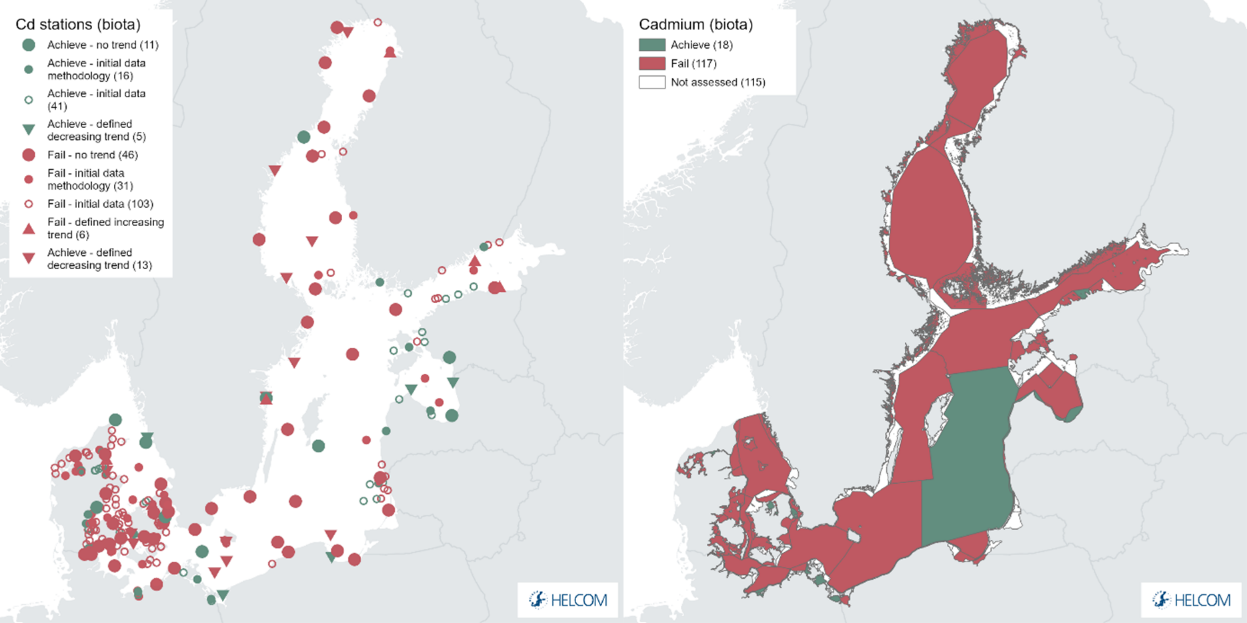
Figure 7. Map presenting station based status of cadmium concentrations in biota (left) and assessment unit based status for cadmium in biota (right). Green colour represents good status and red colour represents not good status. Large filled triangles indicate data series of three or more years for which statistical trends could be assigned (upwards-increasing concentrations or downwards-decreasing concentrations), large filled circles triangles indicate data series of three or more years for which statistical trends could be assigned but where no detectible trend was observed, and full evaluation with MIME Script (see Methodology) was carried out. Small filled circles represent data series of three or more years for which statistical trends could not be assigned due to specific data factors and open circles represent data series of less than three for which statistical trends could not be assigned due to data series length, and these data types are treated with initial status assessment (see Methodology). See ‘data chapter’ for interactive maps and data at the HELCOM Map and Data Service.
Stations with ‘full’ (>3 years of data in the assessment period) and ‘initial’ data (<2 years of data in the assessment period), the latter which limits the application of the full statistical analyses, were available to support the evaluation. There is a high spatial coverage of stations with long time series (‘full’ data) for this evaluation at the Baltic Sea scale. Examples of different trend patterns at the station level (station time series) are presented in Figure 8.
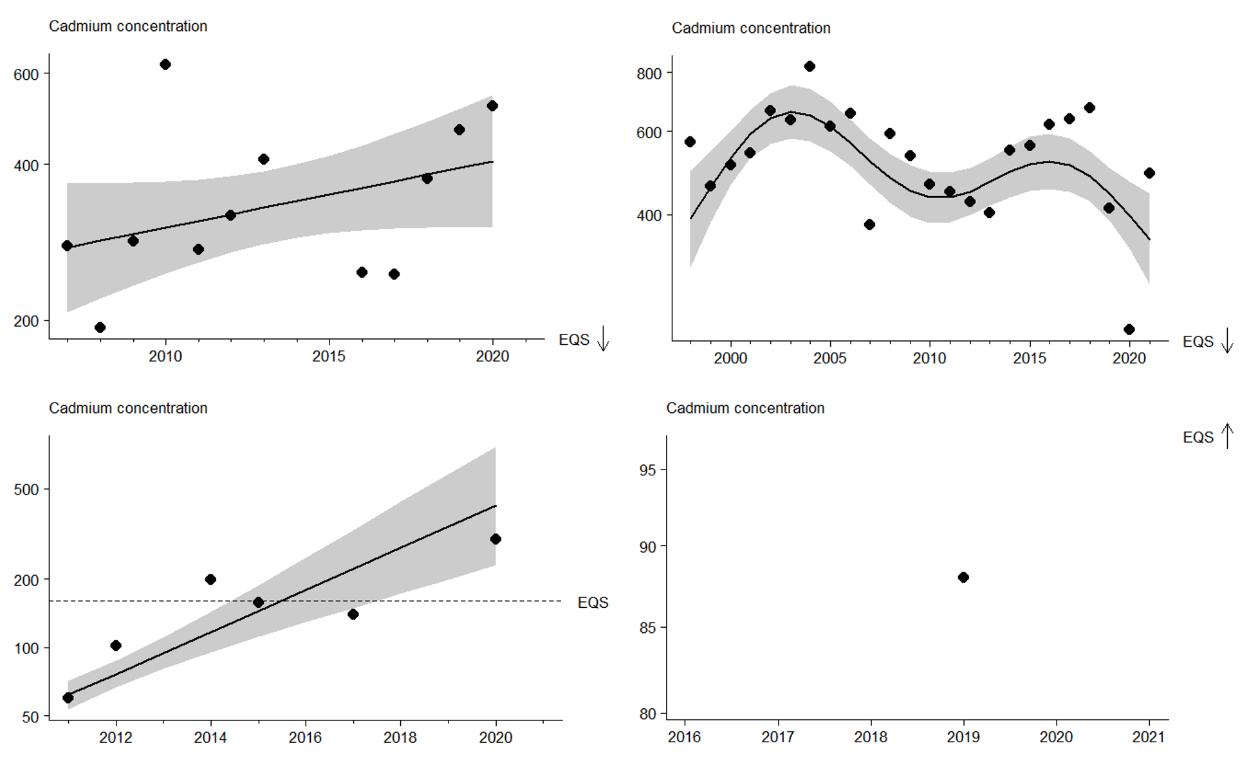
Figure 8. Examples of Cadmium concentration in biota at stations (grey colour- confidence level 95% range (see Methodology)) in the Arkona Basin (top left – Abbekås, no distinct directional trend, ‘full data’, sub-GES), the Eastern Gotland Basin (top right – LWLA, distinct downward trend, ‘full data’, sub-GES), the Gulf of Finland (bottom left – SJB1453000, distinct upward trend, ‘full data’, sub-GES), and the Eastern Gotland Basin (bottom right – no distinct directional trend, ‘initial’ data, in GES).
Sediment
The evaluation of sediment in the core indicator evaluating Cadmium (Cd) is possible for 30 assessment units, of which 13 were open sea HELCOM sub-basins (of a possible 17 sub-basins). Five of the open sea assessment unit failed to achieve the threshold value (were sub-GES) and of the remaining 17 coastal station only four achieved the threshold value (were in GES) (Figure 9).
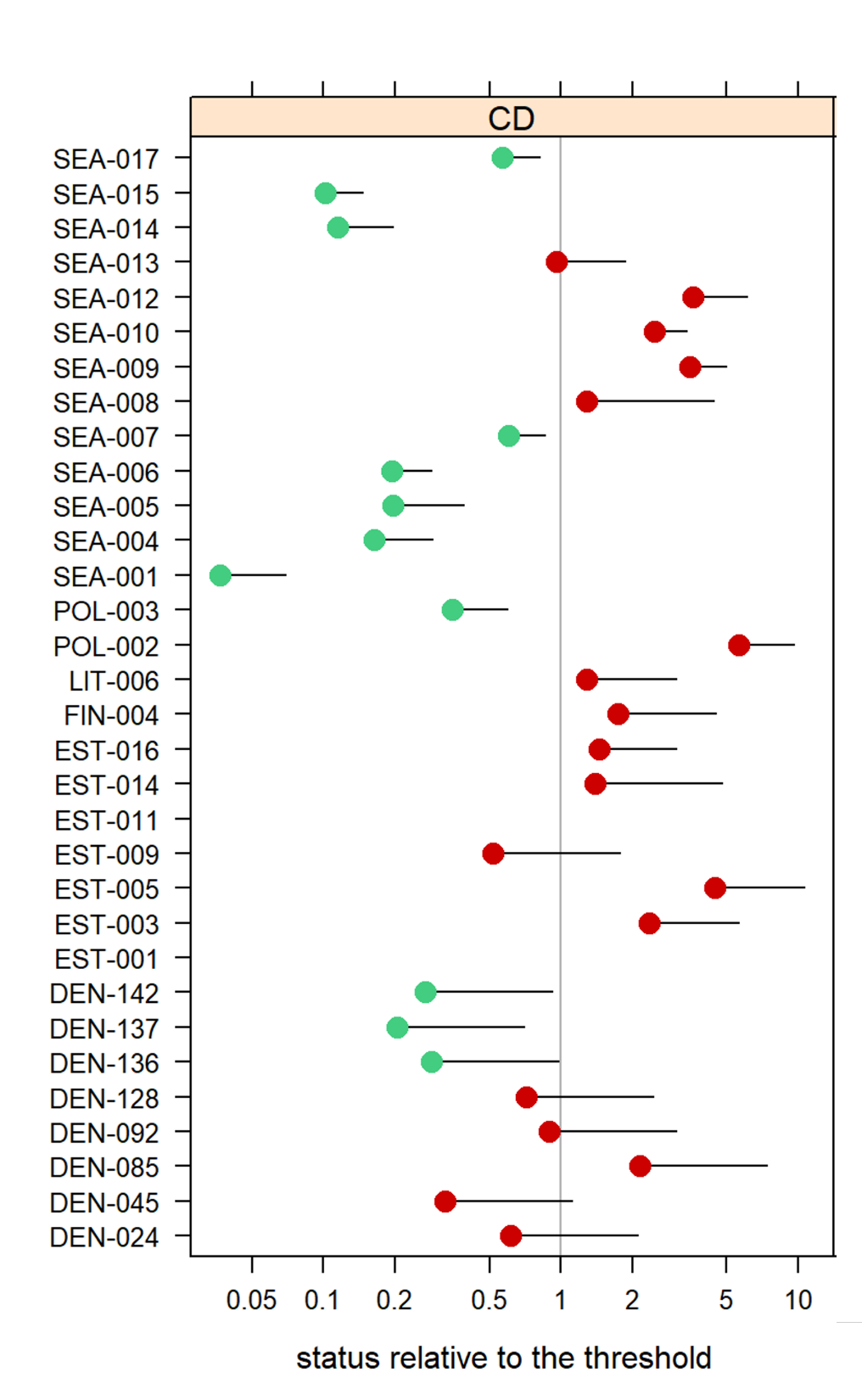
Figure 9. Overview of HELCOM Level 4 assessment units evaluated for Cadmium (Cd) in sediment. The 95% confidence limit on the mean concentration is presented. Filled circles represent a mean value for each assessment unit and the bar represents the upper 95% confidence limit. Green colour indicates that the assessed area achieves the threshold value and red colour that the assessed area fails the threshold.
The concentration in the last year of the evaluation (i.e. the most recent concentration in any given data series) is informative of latest reference point and will occur in the current assessment period. At the station level (i.e. per data series) the concentrations in the last year of evaluation (mg/kg) varied, in cases somewhat widely even within a single sub-basin. This varied between and within the 17 HELCOM sub-basins when comparing all stations, inclusive of open sea and coastal, within each sub-basin (Table 5). These values show the variation across sub-basins and also the latest station level concentrations in the assessment period but do not themselves reflect status as status is derived from the entire assessment period and is also influenced the 95% confidence limit on the mean concentration (as in Figure 9).
Table 5. Overview of number of stations within each HELCOM sub-basin (coastal and open sea), the mean value of the concentrations in the last year of assessment across the stions and the lowest and largest of these values within each sub-basin (where evaluated).
| HELCOM sub-basin | Mean
(mg/kg) |
Number of stations | Lowest concentration (mg/kg) | Largest concentration (mg/kg) |
| Kattegat (SEA-001) | 0.7 | 4 | 0.1 | 1.4 |
| Great Belt (SEA-002) | 2.0 | 5 | 0.6 | 5.0 |
| The Sound (SEA-003) | NA | NA | NA | NA |
| Kiel Bay (SEA-004) | 0.4 | 2 | 0.4 | 0.4 |
| Bay of Mecklenburg (SEA-005) | 0.5 | 1 | 0.5 | 0.5 |
| Arkona Basin (SEA-006) | 0.5 | 3 | 0.4 | 0.6 |
| Bornholm Basin (SEA-007) | 3.7 | 5 | 0.5 | 13.0 |
| Gdansk Basin (SEA-008) | 1.9 | 2 | 0.8 | 3.0 |
| Eastern Gotland Basin (SEA-009) | 5.5 | 5 | 0.6 | 12.4 |
| Western Gotland Basin (SEA-010) | 6.4 | 3 | 3.6 | 9.9 |
| Gulf of Riga (SEA-011) | 3.5 | 4 | 1.2 | 7.5 |
| Northern Baltic Proper (SEA-012) | 8.3 | 1 | 8.3 | 8.3 |
| Gulf of Finland (SEA-013) | 6.0 | 7 | 1.2 | 14.1 |
| Åland Sea (SEA-014) | 0.3 | 1 | 0.3 | 0.3 |
| Bothnian Sea (SEA-015) | 0.3 | 3 | 0.2 | 0.3 |
| The Quark (SEA-016) | NA | NA | NA | NA |
| Bothnian Bay (SEA-017) | 1.3 | 2 | 1 | 1.7 |
The status evaluation is derived based on the station level evaluation of 48 individual stations across the Baltic Sea region. Six of these stations represented ‘full data’ and no distinct downward trends were recorded (1 of which was sub-GES). The low number of long-term time series is in part due to the relatively infrequent sampling that is standard practice for sediment monitoring. There are however spatial gaps in the monitoring of sediment at the Baltic Sea scale (Figure 10).
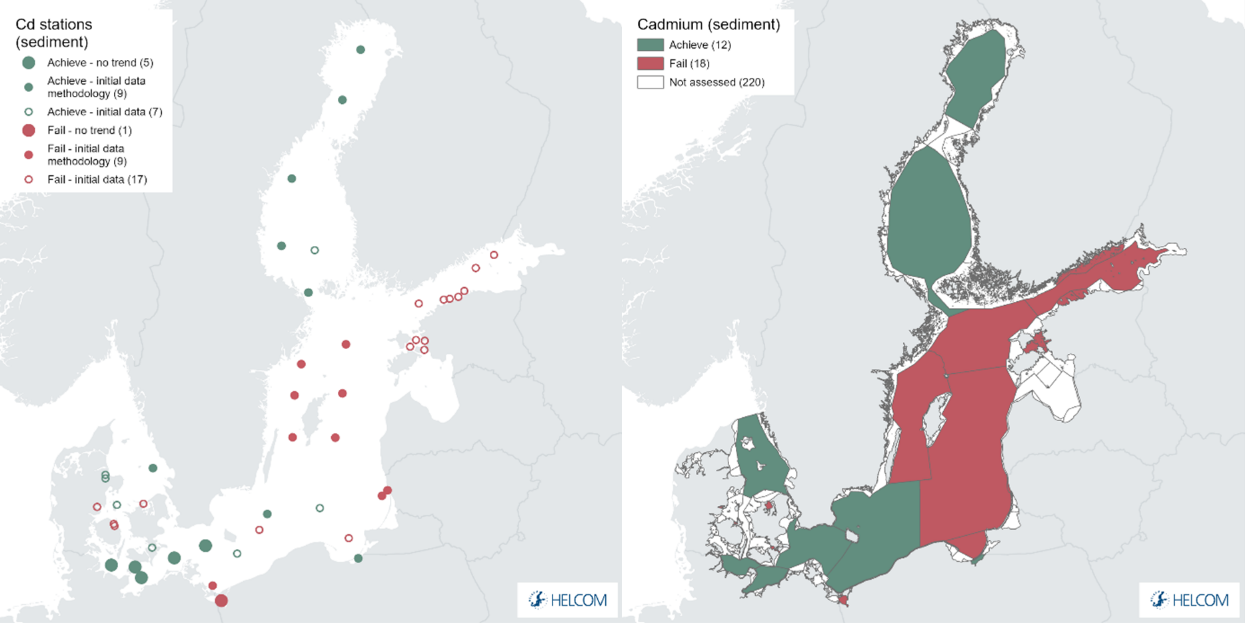
Figure 10. Map presenting station based status of cadmium concentrations in sediment (left) and assessment unit based evaluation for cadmium in sediment (right). Large filled triangles indicate data series of three or more years for which statistical trends could be assigned (upwards-increasing concentrations or downwards-decreasing concentrations), large filled circles triangles indicate data series of three or more years for which statistical trends could be assigned but where no detectible trend was observed, and full evaluation with MIME Script (see Assessment protocol) was carried out. Small filled circles represent data series of three or more years for which statistical trends could not be assigned due to specific data factors and open circles represent data series of less than three for which statistical trends could not be assigned due to data series length, and these data types are treated with initial status assessment (see Methodology). See ‘data chapter’ for interactive maps and data at the HELCOM Map and Data Service.
4.2 Trends
Examples of key station level trends at selected stations are provided above (Figures 5 and 8). The evaluation of cadmium includes a large number of high-quality datasets with long trends and the possibility to assign statistical trends, however this does differ between the monitoring matrices evaluated. Trends are described for each matrix separately.
In water only 2 downward trends (distinct decreasing concentrations) were recorded.
In biota 18 downward trends and 6 upward trends (distinct increasing concentrations) were recorded.
No trends were recorded for evaluation of sediment.
4.3 Discussion text
Cadmium is persistent and not degraded and can cause significant harmful effects in the marine environment if suitable levels are exceeded. While trends for decreasing concentrations (downward trends) in biota outweigh those where deterioration appears to occur (upward trends) by circa three-fold there remains generally sub-GES conditions across the Baltic Sea region, especially where all evaluated sampling matrices are utilized. Local variation can also be seen, particularly in areas dominated by shorter (‘initial’) data series.
In addition, variation in the results may be generated due to the different monitoring matrices applied (Figure 11), an issue that may be relevant for further study beyond HOLAS 3. The EQS used is set for whole fish while a recent study indicate that muscle concentrations are considerably below whole fish concentrations and liver concentrations are considerably above (Soerensen et al. 2023). An initial overview of Helcom data suggest that there is a low bias for fish muscle samples (these generally contributing a small portion of the data) resulting in these samples being more likely to achieve the threshold value. On the other hand, the liver samples are likely biased high compared to the whole fish EQS threshold. Further studies beyond HOLAS 3 are needed to carry out a proper evaluation of this issue.
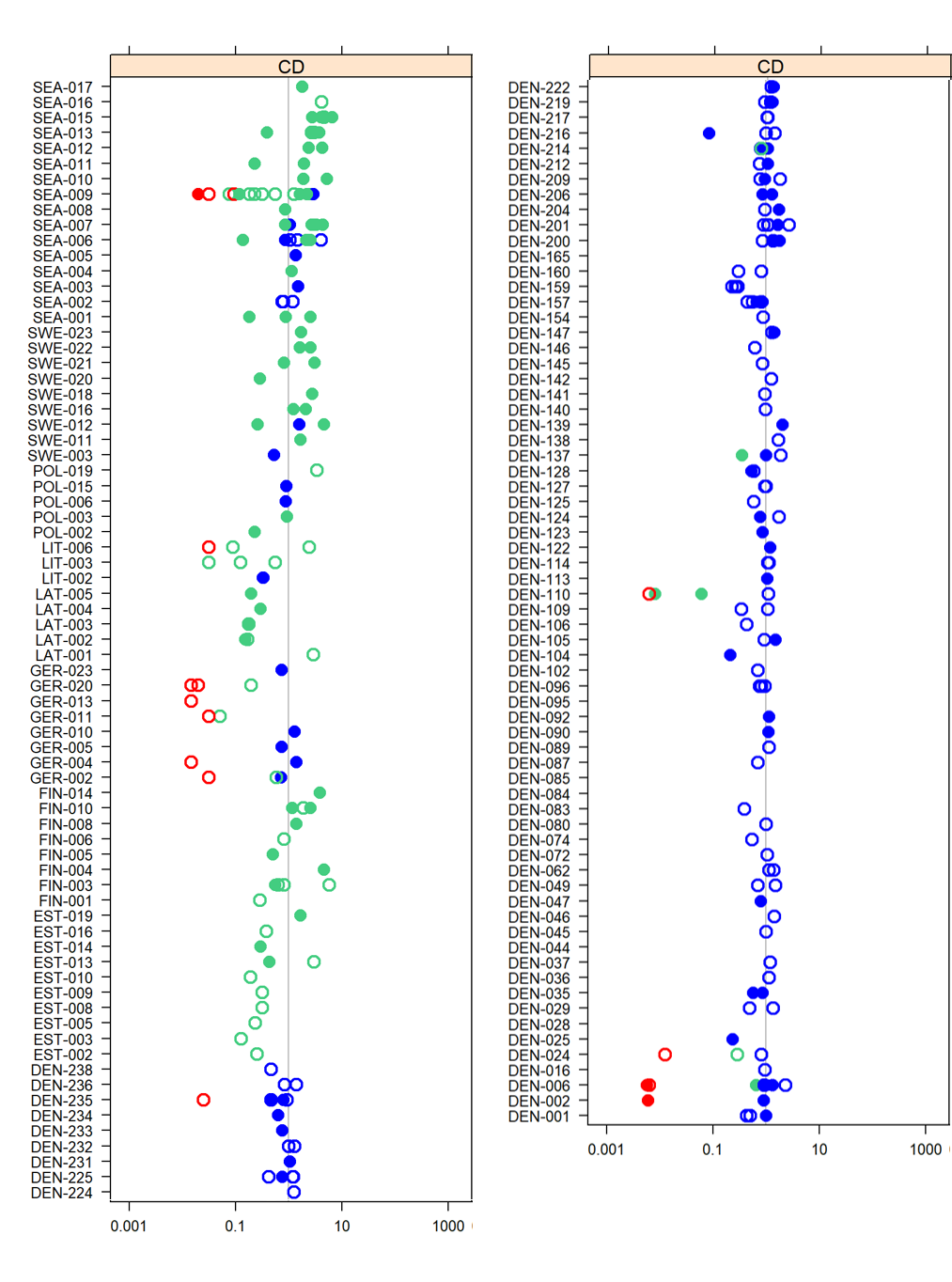
Figure 11. The same assessment units as shown in Figure 3 are presented but each assessment unit visualises the individual stations included in making the assessment unit level status evaluation. Potential difference in evaluation outcome due to different sampling matrices are highlighted: Red = fish muscle, blue = mussel soft body, and green = fish liver. Filled circles indicator ‘full data series’ and open circles indicate ‘initial’ data series.
An overview of the outcomes for the open sea sub-basins is provided below (Table 6).
Table 6. Overview of evaluation outcomes and comparison with previous evaluation (using the OOAO evaluation outcomes per assessment unit). Currently this approach is only applied for open sea assessment units.
| HELCOM Assessment unit name (and ID) | Threshold value achieved/failed – HOLAS II | Threshold value achieved/failed – HOLAS 3 | Distinct trend between current and previous evaluation. | Description of outcomes, if pertinent. |
|---|---|---|---|---|
| Kattegat (SEA-001) | Achieved | Failed | Deterioration in status outcome. Likely driven by greater data availability and the implementation of a new threshold value. | The threshold value is not achieved (sub-GES). The majority of ‘full’ data stations fail to achieve the threshold value (mainly biota). |
| Great Belt (SEA-002) | Achieved | Failed | Deterioration in status outcome. Likely driven by greater data availability and the implementation of a new threshold value. | The threshold value is not achieved (sub-GES). The ‘initial’ data stations fail to achieve the threshold value (biota). |
| The Sound (SEA-003) | Not evaluated | Failed | NA | |
| Kiel Bay (SEA-004) | Achieved | Failed | Deterioration in status outcome. Likely driven by greater data availability and the implementation of a new threshold value. The OAOA failure of GES is driven by biota. | The threshold value is not achieved (sub-GES). Water and sediment achieve their threshold values but biota does not. |
| Bay of Mecklenburg (SEA-005) | Failed | Failed | No change in status between the two assessment periods. | |
| Arkona Basin (SEA-006) | Failed | Failed | No change in status between the two assessment periods. | |
| Bornholm Basin (SEA-007) | Failed | Failed | No change in status between the two assessment periods. | The threshold value is not achieved (sub-GES). The majority of water and sediment stations achieve their threshold values but biota does not. |
| Gdansk Basin (SEA-008) | Failed | Failed | No change in status between the two assessment periods. | The threshold value is not achieved (sub-GES). Neither sediment or biota achieve their threshold values. |
| Eastern Gotland Basin (SEA-009) | Failed | Failed | No change in status between the two assessment periods. | The threshold value is not achieved (sub-GES). Water, sediment and biota stations fail to achieve their threshold values. |
| Western Gotland Basin (SEA-010) | Failed | Failed | No change in status between the two assessment periods. | The threshold value is not achieved (sub-GES). Sediment and biota stations fail to achieve their threshold values. |
| Gulf of Riga (SEA-011) | Not evaluated | Failed | New data availability has facilitated an evaluation for this assessment period. | The threshold value is not achieved (sub-GES) Monitoring only occurs in biota. |
| Northern Baltic Proper (SEA-012) | Failed | Failed | No change in status between the two assessment periods. | The threshold value is not achieved (sub-GES). Sediment and biota stations fail to achieve their threshold values. |
| Gulf of Finland (SEA-013) | Not evaluated | Failed | New data availability has facilitated an evaluation for this assessment period. | |
| Åland Sea (SEA-014) | Achieved | Achieved | No change in status between the two assessment periods. | The threshold value is achieved (GES). Only a single sediment station is evaluated. |
| Bothnian Sea (SEA-015) | Achieved | Failed | Deterioration in status outcome. Likely driven by greater data availability and the implementation of a new threshold value. | The threshold value is not achieved (sub-GES). Sediment achieved the threshold value but biota did not. |
| The Quark (SEA-016) | Not evaluated | Failed | New data availability has facilitated an evaluation for this assessment period. | The threshold value is not achieved (sub-GES) Monitoring only occurs in biota. |
| Bothnian Bay (SEA-017) | Failed | Failed | No change in status between the two assessment periods. | The threshold value is not achieved (sub-GES). Sediment achieved the threshold value but biota did not. |
5 Confidence
The overall confidence of the indicator evaluation is generally moderate, with some assessment units being classified as high or low confidence (Figure 12 and further details in Annex 1).
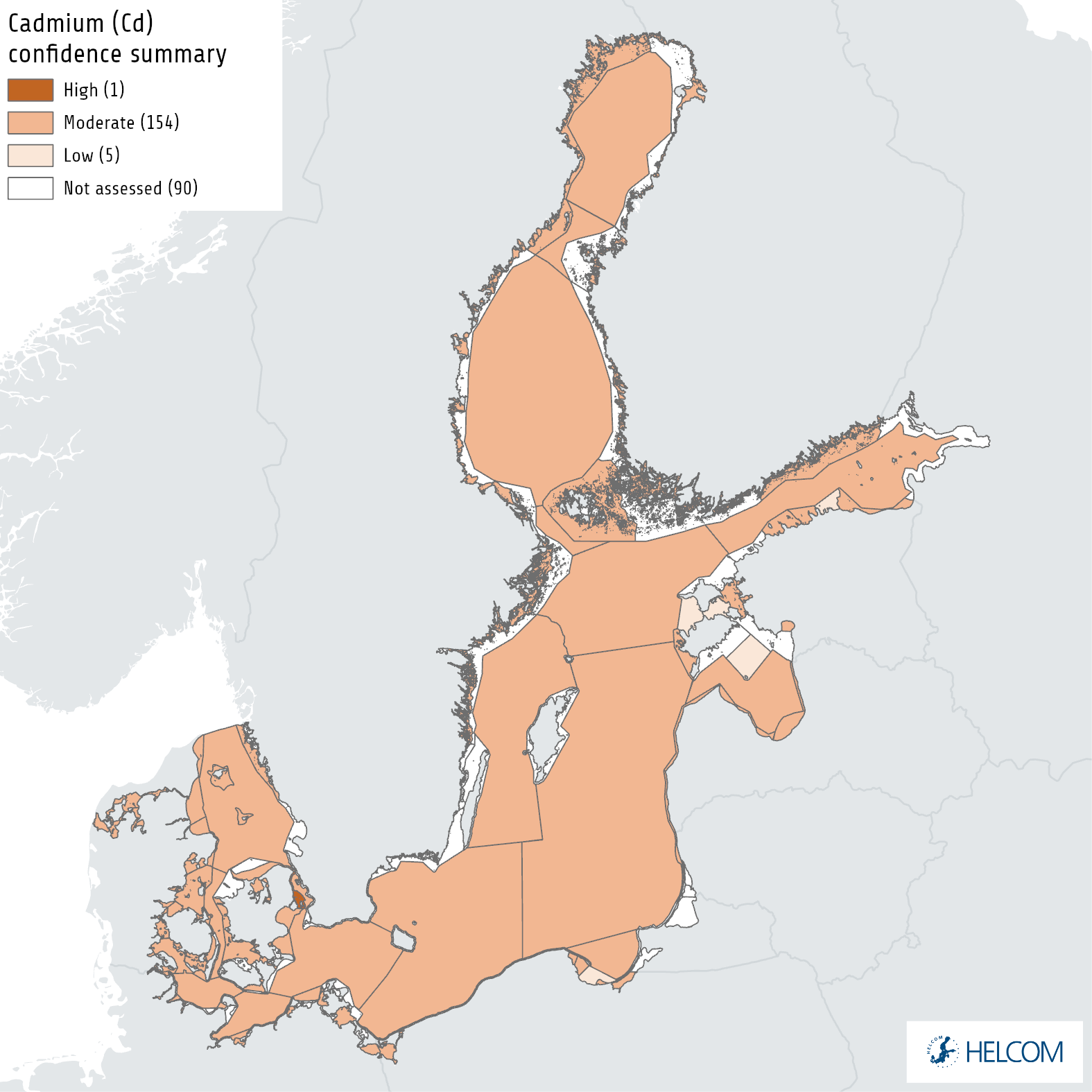
Figure 12. Map presenting the confidence in the overall evaluation based on a OOAO summary of confidence across all monitored matrices (see Annex 1). The evaluation is carried out using Level 4 HELCOM assessment units (defined in the HELCOM Monitoring and Assessment Strategy Annex 4).
The accuracy of the estimation method is considered to be high, and the risk of false status classifications is considered to be very low. The underlying monitoring data is of high quality and regionally comparable.
The data on cadmium concentrations in seawater was reported by Estonia, Germany, Lithuania and Poland and covers 10 sub-basins. The confidence of the evaluation based on seawater results is medium.
The data on metal concentrations in fish and bivalves, as well as in sediment, is generally spatially adequate and time series are available for several stations, therefore the confidence in the results is high.
There is however scope for improved spatial and temporal coverage, some of which will be addressed naturally by the next evaluation as additional years of monitoring results in improved time series of data.
6 Drivers, Activities, and Pressures
Drivers are often large and complex issues that are difficult to quantify, though in certain instances proxies can be utilised to express them or changes in them. A driver for example may relate to globalisation or political will and, while difficult to quantify in terms of specific relevance to an indicator, changes in drivers can catalyse changes in activities that will consequently influence pressures for example resulting in altered levels of shipping and the subsequent pressures for that activity. A brief overview of key pressures and activities is provided in Table 7.
One of the biggest sources of environmental pollution, including the marine environment, with heavy metals, thus with cadmium is the combustion of solid fuels – such as coal, lignite, peat and wood – both in industrial and domestic conditions. Current legal use of cadmium includes rechargeable Ni-Cd batteries. Cadmium has pollution hotspots in connection with metal processing facilities and coexists with all zinc ores, and is typically present at levels of 0.5–2% in the final products. Weathering of outdoor zinc products thus leads to cadmium pollution. In the last decades, EU or worldwide legislation has been put in place banning most uses of heavy metals.
The main routes of cadmium transport to the Baltic Sea are atmospheric deposition and river inflow (https://helcom.fi/wp-content/uploads/2019/08/BSEP162.pdf). The atmospheric deposition to the Baltic Sea can also originate from the transport of metals from outside the Baltic Sea catchment area.
Table 7. Brief summary of relevant pressures and activities with relevance to the indicator.
| | General | MSFD Annex III, Table 2a |
| Strong link | Substances, litter and energy
|
|
| Weak link |
7 Climate change and other factors
The observed climate change may impact the distribution and levels of cadmium in the marine environment. Among the direct parameters of climate change, the fate of cadmium in the Baltic Sea environment may be affected by the following:
- Seawater temperature – an increase in water temperature may affect the metabolism of marine organisms and increase the efficiency of bioaccumulation of cadmium
- Large-scale atmospheric circulation – it can affect the transport of pollutants, including cadmium and thus influence the amount of deposition to the waters of the Baltic Sea
- Precipitation – changes in the precipitation regime may affect the amount of atmospheric cadmium deposition to the Baltic Sea
- River run-off – may be an important source of cadmium entering the Baltic Sea; increasing the inflow in flood situations increases the inflow of lead
- Carbonate chemistry – changes in the pH of the aquatic environment may affect the transformations and thus the chemical forms of cadmium in the marine environment; they may affect also the metabolism of organisms and thus the efficiency of bioaccumulation of cadmium
- Sediment transportation – due to significant amounts of cadmium deposited in bottom sediments, dynamics at the bottom and transport of sediments may lead to re-release and secondary isotope release (from historic deposits and past bioproductivity, Frederiksen et al., 2022)
Among the indirect parameters of climate change affecting cadmium fate in the marine environment are changes in oxygen levels. Projected warming may enhance oxygen depletion in the Baltic Sea, which may influence the biogeochemical processes involving cadmium.
8 Conclusions
In general, the indicator is fully operational and a wide-ranging evaluation can be made across the region. Cadmium persists in the environment and is toxic to marine life at elevated concentrations. A number of decreasing trends are detected, offering a good indication of improving conditions, however the evaluation of Good Environmental Status (GES) generally results in sub-GES conditions. In certain assessment units the threshold values in water and/or sediments are achieved, even in certain cases for biota. However, it is common in biota, the most widely evaluated monitoring matrix across the region, that sub-GES conditions are identified. This results in a general failure to achieve GES when all matrices are incorporated.
8.1 Future work or improvements needed
The current annual sampling of water, biota and sediment is generally considered to be of adequate frequency for the core indicator. The biota monitoring in each sub-basin depends on the availability of certain species during the time of monitoring cruises and cannot be secured at all times. Further development of the confidence evaluation is likely valuable. Exploring the potential to include or incorporate sediment core information (i.e. results from dated sediment core analyses) into future versions of this report would be interesting and informative, especially in relation to trends.
Countries should consider extending monitoring to include cadmium measurements in seawater.
9 Methodology
The overall methodology is set out below.
9.1 Scale of assessment
The core indicator evaluates the status with regard to concentrations of metals using HELCOM assessment unit scale 4 (division of the Baltic Sea into 17 sub-basins division into coastal and offshore areas, and the coastal areas further divided into WFD water types or bodies).
The assessment units are defined in the HELCOM Monitoring and Assessment Strategy Annex 4.
9.2 Methodology applied
The evaluation is carried out using an agreed R-script (MIME) that applies the statistical analysis.
To evaluate the contamination status of the Baltic Sea, the ratio of the concentration of a metal to the specified concentration (threshold) levels is used for each biotic and abiotic elements (matrix) of the marine environment. A ratio above 1 therefore indicates non-compliance (failure to meet threshold). Taking into account the scope of monitoring programmes implemented by the EU MS regarding heavy metals, and the target concentrations of individual elements, the appropriate measurement matrices were recommended to allow the use of results in Descriptor 8.
All available data on cadmium (in seawater, biota-mussels and bottom sediments) concentrations up to 2016, reported by HELCOM Contracting Parties to the HELCOM COMBINE database, were used to assess the state of the Baltic Sea environment.
The evaluation of the present environmental status in respect of heavy metal content has been carried out in all assessment units at scale 4, where data availability was sufficient.
The basis for the evaluation carried out in the sub-basins was the determination of the concentrations of individual metals in the respective matrices for each station, which were then compared with threshold values to determine the contamination ratio (CR). Good status in respect of single element is scored if CR ≤1.
A two-way approach was used to determine the representative concentrations of the individual metals in the individual matrices. In the case of stations where long-term data series exist, the agreed script (MIME Script) was used. This method allows determination of the upper value of the 95% confidence level which is regarded as a representative concentration. In the case of stations where data are from 1-2 years only or ‘less-than’ values make the correct assignment of the above statistical procedures impossible then data are treated as ‘initial’ data. All initial data is handled in a highly precautionary manner to further ensure that the risk of false positives is minimalised. For all initial data the 95% confidence limit on the mean concentration, based on the uncertainty seen in longer time series throughout the HELCOM area, is used. Applying a precautionary approach, the 90% quantile (psi value, Ψ) of the uncertainty estimates in the longer time series from the entire HELCOM region are used. The same approach is used for time series with three or more years of data, but which are dominated by less-than values (i.e. no parametric model can be fitted). The mean concentration in the last monitoring year (meanLY) is obtained by: restricting the time series to the period 2016-2021 (the last six monitoring years), calculating the median log concentration in each year (treating ‘less-than’ values as if they were above the limit of detection), calculating the mean of the median log concentrations, and then back-transforming (by exponentiating) to the concentration scale. The upper one-sided 95% confidence limit (clLY) is then given by:
 where n is the number of years with data in the period 2016-2021 (HELCOM 2018).
where n is the number of years with data in the period 2016-2021 (HELCOM 2018).
In order to ensure comparability of the measurements to the core indicator threshold value, the data to be extracted from the HELCOM COMBINE database has been defined in a so called ‘extraction table’. Relevant sections of the extraction table are presented in Table 2.
The evaluation of the present environmental status in respect of heavy metal content should be carried out, if possible – regarding data availability, in all assessment units (assessment units at scale 4).
9.3 Monitoring and reporting requirements
Monitoring methodology
HELCOM common monitoring of relevance to the indicator is described on a general level in the HELCOM Monitoring Manual in the programme topic: Concentrations of contaminants.
Quality assurance in the form of international workshops and proficiency testing has been organized annually by QUASIMEME since 1993, with two rounds each year for water, sediment and biota.
Current monitoring
The monitoring activities relevant to the indicator that is currently carried out by HELCOM Contracting Parties are described in the HELCOM Monitoring Manual in the relevant Monitoring Concept Tables.
Sub-programme: Contaminants in biota
Monitoring Concept Table
Sub-programme: Contaminants in water
Monitoring Concept Table
Sub-programme: Contaminants in sediment
Monitoring Concept Table
Concentrations of cadmium are being monitored by all the Baltic Sea countries. In addition to long-term monitoring stations of herring, cod, perch, flounder and eelpout, there is a fairly dense grid of monitoring stations for mussels and perch at the shoreline, but very few stations in the open areas of the Baltic Sea. The monitoring is, however, considered to be representative.
Description of optimal monitoring
Cadmium concentrations are spatially highly varying in the Baltic Sea. Therefore, a dense network of monitoring stations is needed to have reliable overviews of the state of the environment. The monitoring should contain both long-lived and mobile species (herring, cod, flounder) and more local species (perch and shellfish).
Sediment monitoring can complement the evaluation. Sediment represents longer timespans than biota (typically years vs. months), and are available in all places, whereas especially local species are not always available for spatial surveys. Time-trends from dated sediment cores in undisturbed (anoxic) areas can be a valuable source of information on the development in concentrations from before monitoring was started and even back to pre-industrialized times.
Monitoring of cadmium, mercury and lead is relevant in the entire sea area.
10 Data
The data and resulting data products (e.g. tables, figures and maps) available on the indicator web page can be used freely given that it is used appropriately and the source is cited.
Data: Hazardous substances in biota
Data: Hazardous substances in sediment
Data: Hazardous substances in water
The indicator is based on data held in the HELCOM COMBINE database, hosted at the International Council for the Exploration of the Seas (ICES).
11 Contributors
Tamara Zalewska – Institute of Meteorology and Water Management – National Research Institute, Poland.
Rob Fryer – Marine Scotland (OSPAR).
HELCOM Expert Group on Hazardous Substances.
HELCOM Secretariat: Owen Rowe, Deborah Shinoda, Joni Kaitaranta, Jana Wolf and Jannica Haldin.
12 Archive
This version of the HELCOM core indicator report was published in April 2023:
The current version of this indicator (including as a PDF) can be found on the HELCOM indicator web page.
Older versions of the core indicator report are available:
Metals HELCOM core indicator 2018 (pdf)
HOLAS II component – core indicator report – web-based version July 2017 (pdf)
HELCOM-CoreIndicator-Metals(Lead, Cadmium, Mercury) 2013 (pdf)
13 References
European Commission (2000) Directive 2000/60/EC of the European Parliament and of the Council of 23 October 2000 establishing a framework for Community action in the field of water policy. Off. J. Eur. Union L 327.
European Commission (2006a) Commission Regulation (EC) No 1881/2006 of 19 December 2006 setting maximum levels for certain contaminants in foodstuffs. Off. J. Eur. Union L 364.
European Commission (2006b) Directive 2006/113/EC of the European Parliament and of the Council of 12 December 2006 on the quality required of shellfish waters. Off. J. Eur. Union L 376.
European Commission (2008a) Directive 2008/56/EC of the European Parliament and the Council establishing a framework for community action in the field of marine environmental policy (Marine Strategy Framework Directive). Off. J. Eur. Union L 164: 19-40.
European Commission (2008b) Directive 2008/105/EC of the European Parliament and the Council on environmental quality standards in the field of water policy (Directive on Environmental Quality Standards). Off. J. Eur. Union L 348.
European Commission (2013) Directive 2013/39/EU of the European Parliament and of the Council of 12 August 2013 amending Directives 2000/60/EC and 2008/105/EC as regards priority substances in the field of water policy. Off. J. Eur. Union L 226: 1-17.
Frederiksen, Klaebe, Farkaš, Swart, and Frei (2022) Cadmium isotopes in Bahamas platform carbonates: A base for reconstruction of past surface water bioproductivity and their link with chromium isotopes. Science of The Total Environment, Volume 806, Part 2
14 Other relevant resources
HELCOM (2010) Hazardous substances in the Baltic Sea – An integrated thematic assessment of hazardous substances in the Baltic Sea. Balt. Sea Environ. Proc. No. 120B.
HELCOM (2018): HELCOM Thematic assessment of hazardous substances 2011-2016. Baltic Sea Environment Proceedings n°157
Law, R., Hanke, G., Angelidis, M., Batty, J., Bignert, A., Dachs, J., Davies, I., Denga, Y., et al. (2010) MARINE STRATEGY FRAMEWORK DIRECTIVE Task Group 8 Report Contaminants and pollution effects. JRC Scientific and Technical Reports.
Annex 1 Assessment unit level confidence summary
Confidence is evaluated per assessment unit based on a relative evaluation of following parameters for the copper indicator: 1) spatial component, 2) temporal component, 3) methodological component, and 4) the evaluation component. Despite the common approach applied with other indicators the information set out here is not directly comparable as it only focusses on an evaluation within each indicator (i.e. is relative only between the evaluated assessment units for copper) and it furthermore only addresses the evaluated units. More general information related to overarching confidence and required improvements are detailed in the main report.
The confidence for each component was applies based on a categorical approach using high, moderate and low. To achieve the overall summary confidence a score of 0.25 was applied to low, 0.5 to moderate and 1.0 to high with an average value calculated across the components and the same scores used to then select he final overall category.
Spatial component: Open sea and coastal areas were treated separately due to the scale of sea area being vastly different. The area (km2) for each evaluated assessment unit was divided by the total number of stations in the assessment unit and the resulting area per station was used to divide into three categories, roughly interpreted as stations addressing small, medium or large areas. If a large number (relatively) of stations were still available despite the area being large an increase of 1 category was applied.
Temporal component: The presence of ‘full’ and/or ‘initial’ data series was utilised to evaluate this. Where only a single initial data series/station was present a category of low was applied, where two initial data series were available a category of moderate was applied, where a single full data series was present a category of moderate was applied, and where two or more full data series were present a category of high was applied.
Methodological component: A score of high is applied to all evaluated assessment units since the indicator is evaluated using the MIME tool and applies a regionally agreed methodology and threshold values on national monitoring data.
Evaluation component: The standard error generated within the MIME assessment tool is utilised as a proxy for this component. In simple terms the basis of this evaluation is that standard error can be roughly equated to a coefficient of variance. This therefore provides a general confidence evaluation of the underlying data and variation within it. A categorical approach was applied where standard error values >0.70 were scored as low, 0.4-0.7 were scored as moderate and <0.4 were scored as high.
The confidence is provided for for water, sediment and biota below (Annex 1 – Tables 1-3)..
The overall confidence for the OOAO status evaluation is also generated using a OOAO approach from these tables below, suing the overall category.
Annex 1 – Table 1. Summary table showing categorical confidence per component and overall for cadmium in water.
| Spatial | Temporal | Methodological | Evaluation | Overall | |
| DEN-113 | High | Low | High | High | Moderate |
| EST-001 | Moderate | Moderate | High | Moderate | Moderate |
| EST-002 | Low | Low | High | Low | Low |
| EST-003 | Moderate | Moderate | High | Moderate | Moderate |
| EST-005 | High | High | High | High | High |
| EST-008 | High | Low | High | Low | Moderate |
| EST-009 | High | Low | High | Low | Moderate |
| EST-010 | Low | Low | High | Low | Low |
| EST-011 | Moderate | Moderate | High | Low | Moderate |
| EST-013 | High | Low | High | Low | Moderate |
| EST-014 | Low | Low | High | Low | Low |
| EST-016 | Moderate | Moderate | High | Moderate | Moderate |
| GER-002 | High | Low | High | High | Moderate |
| GER-005 | High | Low | High | High | Moderate |
| GER-007 | High | Low | High | Moderate | Moderate |
| GER-010 | Moderate | Moderate | High | High | Moderate |
| GER-013 | Moderate | Low | High | Moderate | Moderate |
| GER-020 | Moderate | Low | High | High | Moderate |
| GER-026B | High | Low | High | High | Moderate |
| GER-029 | High | Low | High | High | Moderate |
| GER-031 | High | Low | High | High | Moderate |
| GER-032 | High | Moderate | High | High | Moderate |
| GER-036A | High | Low | High | Low | Moderate |
| GER-044 | High | Moderate | High | High | Moderate |
| LIT-002 | High | Moderate | High | High | Moderate |
| LIT-003 | High | Low | High | Moderate | Moderate |
| LIT-006 | High | Low | High | Moderate | Moderate |
| POL-001 | High | Low | High | Low | Moderate |
| POL-002 | High | High | High | High | High |
| POL-003 | High | Moderate | High | High | Moderate |
| POL-004 | High | Low | High | Low | Moderate |
| POL-005 | Moderate | Low | High | Low | Moderate |
| POL-006 | Low | Low | High | Low | Low |
| POL-007 | High | Low | High | Low | Moderate |
| POL-008 | High | Low | High | Moderate | Moderate |
| POL-009 | High | Moderate | High | Moderate | Moderate |
| POL-010 | High | Low | High | Low | Moderate |
| POL-011 | High | Low | High | Low | Moderate |
| POL-012 | High | Low | High | Low | Moderate |
| POL-014 | High | Low | High | Low | Moderate |
| POL-015 | High | Low | High | Low | Moderate |
| POL-016 | High | Low | High | Low | Moderate |
| POL-017 | High | Low | High | Low | Moderate |
| POL-018 | High | Moderate | High | High | Moderate |
| POL-019 | High | Low | High | Low | Moderate |
| SEA-004 | High | Moderate | High | High | Moderate |
| SEA-005 | High | Moderate | High | High | Moderate |
| SEA-006 | Moderate | High | High | High | Moderate |
| SEA-007 | Moderate | High | High | High | Moderate |
| SEA-009 | Low | Moderate | High | High | Moderate |
Annex 1 – Table 2. Summary table showing categorical confidence per component and overall for cadmium in sediment.
| Spatial | Temporal | Methodological | Evaluation | Overall | |
| DEN-024 | High | Low | High | Low | Moderate |
| DEN-045 | High | Low | High | Low | Moderate |
| DEN-085 | High | Low | High | Low | Moderate |
| DEN-092 | High | Low | High | Low | Moderate |
| DEN-128 | High | Low | High | Low | Moderate |
| DEN-136 | High | Low | High | Low | Moderate |
| DEN-137 | High | Low | High | Low | Moderate |
| DEN-142 | High | Low | High | Low | Moderate |
| EST-003 | High | Moderate | High | Moderate | Moderate |
| EST-005 | High | Moderate | High | Moderate | Moderate |
| EST-009 | High | Low | High | Low | Moderate |
| EST-014 | Low | High | Low | Moderate | |
| EST-016 | High | Moderate | High | Moderate | Moderate |
| FIN-004 | Low | High | Moderate | Moderate | |
| LIT-006 | High | Moderate | High | Moderate | Moderate |
| POL-002 | High | Moderate | High | High | Moderate |
| POL-003 | High | Moderate | High | High | Moderate |
| SEA-001 | Low | Moderate | High | High | Moderate |
| SEA-004 | High | High | High | High | High |
| SEA-005 | High | Moderate | High | Moderate | Moderate |
| SEA-006 | High | High | High | High | High |
| SEA-007 | Moderate | High | High | High | Moderate |
| SEA-008 | High | Low | High | Low | Moderate |
| SEA-009 | Low | High | High | High | Moderate |
| SEA-010 | Moderate | High | High | High | Moderate |
| SEA-012 | Low | Moderate | High | High | Moderate |
| SEA-013 | Moderate | Moderate | High | Moderate | Moderate |
| SEA-014 | High | Moderate | High | High | Moderate |
| SEA-015 | Low | High | High | High | Moderate |
| SEA-017 | Moderate | High | High | High | Moderate |
Annex 1 – Table 3. Summary table showing categorical confidence per component and overall for cadmium in biota.
| Spatial | Temporal | Methodological | Evaluation | Overall | |
| DEN-001 | High | High | High | Moderate | Moderate |
| DEN-002 | High | High | High | Moderate | Moderate |
| DEN-006 | High | High | High | High | High |
| DEN-016 | High | Low | High | Low | Moderate |
| DEN-024 | High | Moderate | High | Moderate | Moderate |
| DEN-025 | High | High | High | Low | Moderate |
| DEN-029 | High | Moderate | High | Low | Moderate |
| DEN-035 | High | High | High | Low | Moderate |
| DEN-036 | High | Low | High | Low | Moderate |
| DEN-037 | High | Low | High | Low | Moderate |
| DEN-045 | High | Low | High | Low | Moderate |
| DEN-046 | Moderate | Low | High | Low | Moderate |
| DEN-047 | High | Moderate | High | Low | Moderate |
| DEN-049 | High | Moderate | High | Low | Moderate |
| DEN-062 | High | Moderate | High | Low | Moderate |
| DEN-072 | High | Low | High | Low | Moderate |
| DEN-074 | High | Low | High | Low | Moderate |
| DEN-080 | High | Low | High | Low | Moderate |
| DEN-083 | High | Low | High | Low | Moderate |
| DEN-087 | High | Low | High | Low | Moderate |
| DEN-089 | High | Low | High | Low | Moderate |
| DEN-090 | High | Moderate | High | Low | Moderate |
| DEN-092 | High | Moderate | High | Low | Moderate |
| DEN-096 | High | Moderate | High | Moderate | Moderate |
| DEN-102 | High | Low | High | Low | Moderate |
| DEN-104 | High | Moderate | High | Low | Moderate |
| DEN-105 | High | High | High | Low | Moderate |
| DEN-106 | High | Low | High | Low | Moderate |
| DEN-109 | High | Moderate | High | Low | Moderate |
| DEN-110 | High | High | High | Low | Moderate |
| DEN-113 | High | Moderate | High | Low | Moderate |
| DEN-114 | High | Moderate | High | Low | Moderate |
| DEN-122 | High | High | High | Low | Moderate |
| DEN-123 | High | High | High | Low | Moderate |
| DEN-124 | High | High | High | Low | Moderate |
| DEN-125 | High | Low | High | Low | Moderate |
| DEN-127 | High | Moderate | High | Low | Moderate |
| DEN-128 | High | High | High | Low | Moderate |
| DEN-137 | High | High | High | Moderate | Moderate |
| DEN-138 | High | Low | High | Low | Moderate |
| DEN-139 | High | Moderate | High | Low | Moderate |
| DEN-140 | High | Low | High | Low | Moderate |
| DEN-141 | High | Low | High | Low | Moderate |
| DEN-142 | High | Low | High | Low | Moderate |
| DEN-145 | High | Low | High | Low | Moderate |
| DEN-146 | High | Low | High | Low | Moderate |
| DEN-147 | High | High | High | Low | Moderate |
| DEN-154 | Moderate | Low | High | Low | Moderate |
| DEN-157 | High | High | High | Moderate | Moderate |
| DEN-159 | High | Moderate | High | Moderate | Moderate |
| DEN-160 | High | Moderate | High | Low | Moderate |
| DEN-200 | High | High | High | Moderate | Moderate |
| DEN-201 | High | High | High | Moderate | Moderate |
| DEN-204 | High | High | High | Moderate | Moderate |
| DEN-206 | Moderate | High | High | Moderate | Moderate |
| DEN-209 | High | High | High | Moderate | Moderate |
| DEN-212 | High | High | High | Low | Moderate |
| DEN-214 | High | High | High | Moderate | Moderate |
| DEN-216 | High | High | High | Low | Moderate |
| DEN-217 | High | Moderate | High | Low | Moderate |
| DEN-219 | Moderate | High | High | Moderate | Moderate |
| DEN-222 | Moderate | High | High | Low | Moderate |
| DEN-224 | High | Low | High | Low | Moderate |
| DEN-225 | High | High | High | Moderate | Moderate |
| DEN-231 | High | Moderate | High | Low | Moderate |
| DEN-232 | High | Moderate | High | Low | Moderate |
| DEN-233 | High | Moderate | High | Low | Moderate |
| DEN-234 | High | Moderate | High | Low | Moderate |
| DEN-235 | High | High | High | Moderate | Moderate |
| DEN-236 | High | Moderate | High | Low | Moderate |
| DEN-238 | High | Low | High | Low | Moderate |
| EST-002 | Moderate | Low | High | Low | Moderate |
| EST-003 | Moderate | Low | High | Low | Moderate |
| EST-005 | Moderate | Low | High | Low | Moderate |
| EST-008 | High | Low | High | Low | Moderate |
| EST-009 | High | Low | High | Low | Moderate |
| EST-010 | Moderate | Low | High | Low | Moderate |
| EST-013 | High | High | High | Low | Moderate |
| EST-014 | Moderate | Low | High | Low | Moderate |
| EST-016 | Moderate | Low | High | Low | Moderate |
| EST-019 | Low | Low | High | Low | Low |
| FIN-001 | Moderate | Low | High | Low | Moderate |
| FIN-003 | High | High | High | Moderate | Moderate |
| FIN-004 | Low | Moderate | High | Low | Moderate |
| FIN-005 | Moderate | Moderate | High | Low | Moderate |
| FIN-006 | Moderate | Low | High | Low | Moderate |
| FIN-008 | Moderate | Moderate | High | Low | Moderate |
| FIN-010 | High | High | High | Moderate | Moderate |
| FIN-014 | Low | Moderate | High | Low | Moderate |
| GER-002 | High | High | High | Moderate | Moderate |
| GER-004 | High | High | High | Moderate | Moderate |
| GER-005 | High | Moderate | High | Low | Moderate |
| GER-010 | High | Moderate | High | Low | Moderate |
| GER-011 | High | Moderate | High | Low | Moderate |
| GER-013 | High | Low | High | Low | Moderate |
| GER-020 | High | Moderate | High | Moderate | Moderate |
| GER-023 | High | Moderate | High | Low | Moderate |
| LAT-001 | High | Low | High | Low | Moderate |
| LAT-002 | High | High | High | Low | Moderate |
| LAT-003 | High | High | High | Low | Moderate |
| LAT-004 | High | Moderate | High | Low | Moderate |
| LAT-005 | Moderate | Moderate | High | Low | Moderate |
| LIT-002 | High | High | High | Low | Moderate |
| LIT-003 | High | Moderate | High | Moderate | Moderate |
| LIT-006 | High | Moderate | High | Moderate | Moderate |
| POL-002 | High | Moderate | High | Low | Moderate |
| POL-003 | High | Moderate | High | Low | Moderate |
| POL-006 | Moderate | Moderate | High | Low | Moderate |
| POL-015 | High | Moderate | High | Low | Moderate |
| POL-019 | High | Low | High | Low | Moderate |
| SWE-003 | Moderate | Moderate | High | Low | Moderate |
| SWE-011 | Low | Moderate | High | Low | Moderate |
| SWE-012 | High | High | High | Moderate | Moderate |
| SWE-016 | Moderate | High | High | Moderate | Moderate |
| SWE-018 | Moderate | Moderate | High | Low | Moderate |
| SWE-020 | High | Moderate | High | Low | Moderate |
| SWE-021 | Moderate | High | High | Moderate | Moderate |
| SWE-022 | Moderate | High | High | Moderate | Moderate |
| SWE-023 | Low | Moderate | High | Low | Moderate |
| SEA-001 | Moderate | High | High | Moderate | Moderate |
| SEA-002 | High | Moderate | High | Moderate | Moderate |
| SEA-003 | High | Moderate | High | Low | Moderate |
| SEA-004 | Moderate | Moderate | High | Low | Moderate |
| SEA-005 | Moderate | Moderate | High | Low | Moderate |
| SEA-006 | Moderate | High | High | High | Moderate |
| SEA-007 | Moderate | High | High | High | Moderate |
| SEA-008 | Moderate | Moderate | High | Low | Moderate |
| SEA-009 | High | High | High | High | High |
| SEA-010 | Low | High | High | Moderate | Moderate |
| SEA-011 | Moderate | High | High | Moderate | Moderate |
| SEA-012 | Low | High | High | Moderate | Moderate |
| SEA-013 | Moderate | High | High | Moderate | Moderate |
| SEA-015 | Moderate | High | High | Moderate | Moderate |
| SEA-016 | Moderate | Low | High | Low | Moderate |
| SEA-017 | Low | Moderate | High | Low | Moderate |
